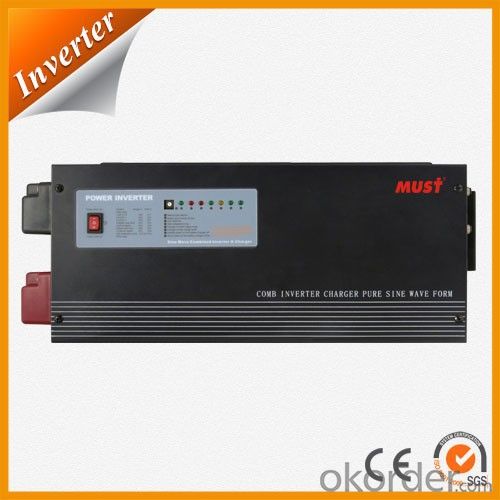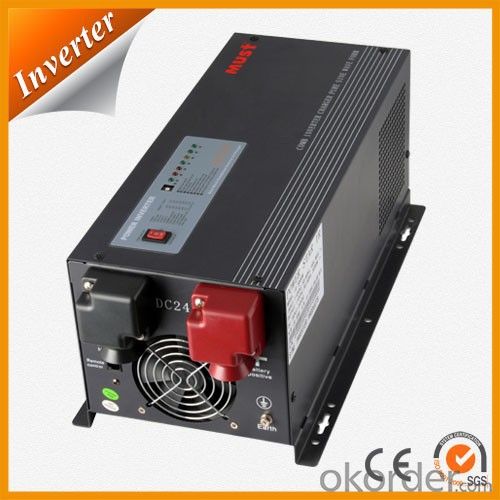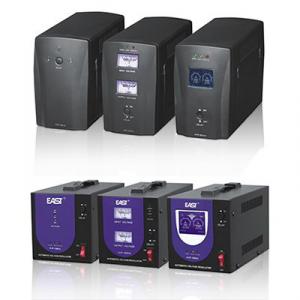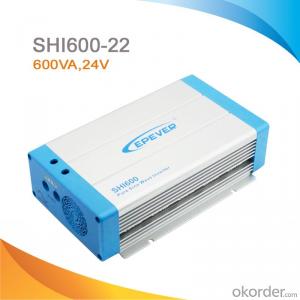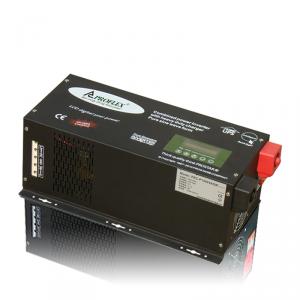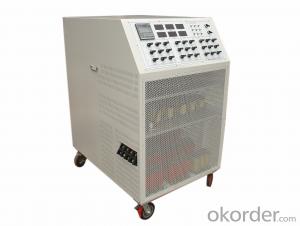5kV Solar Inverter - Pure Sine Wave Inverter Home Inverter 600-3500W
- Loading Port:
- China main port
- Payment Terms:
- TT or LC
- Min Order Qty:
- 100 pc
- Supply Capability:
- 1000 pc/month
OKorder Service Pledge
OKorder Financial Service
You Might Also Like
| Home Inverter 600-3500W |
Home Inverter 600W-3500W is Pure sine wave output inverter which are specially used for house appliance such as TV, refrigerator, fan, air conditioner etc, and also it can be used as UPS for computers. That means It can supply power to various loads such as resitive load, inductive load, motors and rectifier load. It is equipped with programmable big current, 3 stages battery charger (10-70Amp adjustable charger) to run 10hrs longer backup time. |
● Reliable, Durable and Economical Power for Grid and Mobile Applications
● Microprocessor based Inverter / Charger provides
● Ultra-clean pure sine wave output with less than 5% total harmonic distortion
● Supply energy to various loads such as resistive load, inductive load, motors and rectifier load.
● Control panel with large LCD
● Powerful 300% surge power
● Low sleep mode power consumption of less than 5W
● Phase & frequency synchronization auto-tracing for seamless transfer time
● Programmable big current, 3 stages battery charger
● Long backup time up to 10 hours (based on the battery bank and loads).
● Easy to install, easy to maintain, and built for years of reliable service
Q. How long the UPS to run when power goes?
This can take 3 paths.
1.You can pick a UPS that is rated for pretty much the full VA you need so it will be running at 100% of capability and will thus last 'n' minutes.
2.You can pick a UPS that is rated at a much higher VA value than you really need so, for example, is running at 50% of capability and will thus last for longer than the UPS from option 1.
3.You can use extra external battery packs to run for longer. If charging capability allows, the more and the bigger batteries you take with, the longer time UPS runs.
or using a generator after about 6 hours, it will be more cost-effective, with a short runtime UPS to bridge the generator start-up gap.Q. What's lifetime of a UPS ?
Most plug-in UPS are workable for at least five years. We'd advise you to change the batteries every three to four years. For larger equipment, we maintain equipment for twenty years old and still going strong.
Q. How to maintain a UPS ?
There are three simple methods: Never overload your UPS, never connect any home electronic devices such as cooling fan to your UPS. This may cause malfunction of your UPS. Discharge the battery in a consistent interval, once a month or once two months. You can do this by turning on the UPS without connecting the mains.

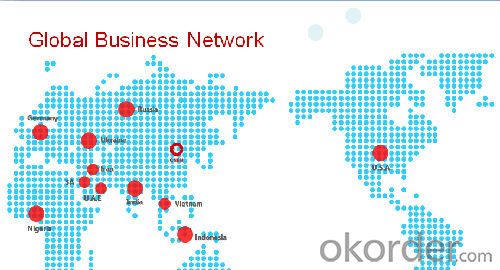
- Q: Is it possible to monitor the performance of a solar inverter remotely?
- Yes, it is possible to monitor the performance of a solar inverter remotely. With the advancements in technology, solar inverters can be equipped with monitoring systems that allow users to monitor their performance, including energy production, efficiency, and any potential issues, through online platforms or mobile applications. Remote monitoring enables users to keep track of their solar energy system's performance and make informed decisions for maintenance or troubleshooting, even when they are not physically present at the installation site.
- Q: What is the role of a power limiter in a solar inverter system?
- The role of a power limiter in a solar inverter system is to regulate and control the amount of power being fed into the grid. It ensures that the solar system does not exceed the maximum allowable power limit set by the utility company. This helps to maintain a stable and reliable power supply, preventing any potential damage to the grid infrastructure and ensuring compliance with grid regulations.
- Q: What is the role of a power factor correction circuit in a solar inverter?
- The role of a power factor correction circuit in a solar inverter is to improve the power quality and efficiency of the inverter by reducing the reactive power and improving the power factor. This circuit ensures that the energy from the solar panels is effectively converted and delivered to the electrical grid, leading to a more stable and efficient operation of the solar inverter system.
- Q: What is the maximum number of AC outputs in a solar inverter?
- The maximum number of AC outputs in a solar inverter can vary depending on the specific model and design of the inverter. However, in general, most residential solar inverters typically have one or two AC outputs, while commercial or utility-scale inverters can have multiple AC outputs, ranging from three to even a dozen or more, depending on the requirements of the installation.
- Q: What is the maximum DC voltage that a solar inverter can handle?
- The maximum DC voltage that a solar inverter can handle varies depending on the specific model and manufacturer. However, in general, most solar inverters can handle DC voltages up to around 1000V.
- Q: What are the different power output modes of a solar inverter?
- The different power output modes of a solar inverter typically include grid-tie mode, off-grid mode, and hybrid mode. In grid-tie mode, the solar inverter synchronizes with the utility grid, allowing excess solar energy to be fed back into the grid. Off-grid mode, on the other hand, enables the solar inverter to operate independently, providing power to appliances and devices without the need for a utility grid connection. Hybrid mode combines the features of both grid-tie and off-grid modes, allowing the solar inverter to function with or without the grid, depending on the availability of solar energy and the user's preferences.
- Q: Can a solar inverter be used for residential applications?
- Yes, a solar inverter can be used for residential applications. A solar inverter is an essential component of a residential solar energy system as it converts the direct current (DC) generated by solar panels into usable alternating current (AC) electricity that can power household appliances and be fed back into the grid.
- Q: How does a solar inverter handle voltage sag or drop in the grid?
- A solar inverter handles voltage sag or drop in the grid by continuously monitoring the grid voltage. When it detects a drop below a certain threshold, it adjusts its own output voltage to compensate and maintain a stable and consistent voltage supply to the connected solar panels or the grid. This ensures that the solar system operates optimally and can seamlessly adapt to any fluctuations in the grid voltage.
- Q: Can a solar inverter be used with different types of mounting systems?
- Yes, a solar inverter can be used with different types of mounting systems. The solar inverter is responsible for converting the direct current (DC) generated by the solar panels into alternating current (AC) that can be used to power electrical devices. It is compatible with various mounting systems such as rooftop, ground-mounted, or pole-mounted installations, as long as the solar panels are properly connected to the inverter.
- Q: Can a solar inverter be used with a solar-powered telecommunications system?
- Yes, a solar inverter can be used with a solar-powered telecommunications system. A solar inverter is an essential component of a solar-powered system as it converts the direct current (DC) generated by solar panels into alternating current (AC) that can be used to power various electrical devices, including telecommunications equipment. By using a solar inverter, the solar-generated electricity can be efficiently utilized to run a telecommunications system, making it a sustainable and environmentally-friendly solution.
Send your message to us
5kV Solar Inverter - Pure Sine Wave Inverter Home Inverter 600-3500W
- Loading Port:
- China main port
- Payment Terms:
- TT or LC
- Min Order Qty:
- 100 pc
- Supply Capability:
- 1000 pc/month
OKorder Service Pledge
OKorder Financial Service
Similar products
Hot products
Hot Searches
Related keywords





